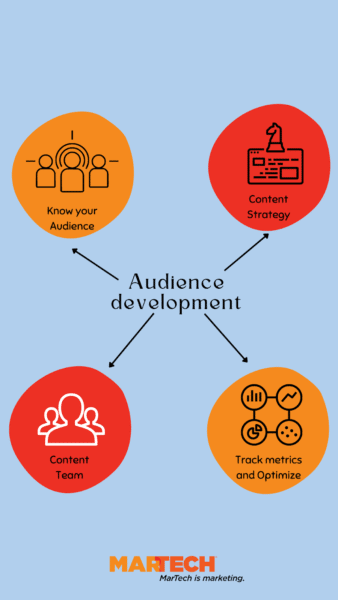
Despite the sea of information available to the 4.95 billion internet users today, fresh content is being generated by the second. Producing engaging content that can distinguish itself within this volume takes a considerable amount of time and effort. In this context, it is critical to develop strategies to keep your audience engaged and further develop your customer base.
It is ironic that social media, one of the most potent conduits of content, is also the force behind the attrition of our attention. With a profusion of content competing for short attention spans, keeping your audience engaged is an increasingly challenging endeavor. However, having a robust audience development plan can help combat this problem.
Audience development is not about volume alone. Of course, marketers like reach, but in an environment where competitors are only a click away, deeper engagement based on trust and an authentic value exchange is of premium value. The value exchange involves delivering valuable content that meets the audience’s needs — not just promotional messaging. It involves performance metrics and optimization to grow the audience and keep it coming back for more.
The key points this article will cover include:
Estimated reading time: 7 minutes
What is audience development?
Broadly defined, audience development is the process of keeping your audience engaged with your business. It starts with getting new consumers to pay attention to your brand, converting them to customers, and finally, building a long-term relationship to foster loyalty amongst those customers. Think of audience development as a timeline that involves attracting customers to your brand and keeping them loyal to your business over time.
Regardless of your industry or business model, customers are essential to running a successful business and the ultimate goal of audience development is to eventually convert the audience for your content into paying customers. How you employ audience development strategies to eventually achieve that goal depends on the context of your business.
With content being produced to cater to every possible niche, it’s difficult to stand out from the competition and keep your audience engaged. You need to have a detailed understanding of your current customer base, and segments within it, to develop strategies that work. This involves putting your audience first and thinking from their perspective.
High-impact audience development strategies
While the best strategies are always context-specific, there are general guidelines that can help with most audience development initiatives. However, marketers need to be mindful of changing customer characteristics and the external environment in which their company operates. The strategies you use should be dynamic and adaptable for maximal impact on consumers.

Here are the factors to consider while developing high-impact audience development strategies:
Get to know your demographic. The first step is to figure out who your audience is. What kind of customers do you want to attract to your brand? Next, divide your customers into segments that include age, gender, and geography. Understand which segment shows the highest engagement with your brand. Do you want to develop this segment further? Perhaps it’s already too saturated, and it makes more sense to chase a new target segment.
Competitor benchmarking can help with this process. For example, what kind of content and campaigns are your competitors running? Who are they targeting? By keeping a close watch over your competitors’ audience development strategies, you can identify which segments are the most reactive and use that data to inform your strategy.
Develop a content strategy. When you know your demographic and have gained familiarity with the marketing practices in your industry, it becomes much easier to develop content that resonates with your audience. You can use a multi-channel strategy that includes producing content for your website, emailing your audience, or leveraging social media platforms to connect with them. Using emerging platforms such as Twitch or Tik-Tok can be effective if you target young consumers.
Define your content team. Figure out who is going to produce your content. The value your content delivers to your customers is crucial. Do you have a team of in-house marketers proficient in developing the kind of content you seek, or would you need to hire external resources? Are you creating a multi-part or a one-time campaign? Further, using the right content management tools to produce effective content is key.
Track metrics and optimize. You need to track the metrics of your content or campaign using content management tools. How many views, clicks, reads, or likes do you get per post? This data will help you fine-tune your future content and improve with each iteration. While your content might be good, it’s futile to use it if it doesn’t reach or engage your target audience.
Optimizing your content for search engines is vital to producing engagement. Make sure your articles have keywords and phrases that are likely to appear in a Google search for the kind of product or service your company sells. Each platform has its unique way of optimizing content for maximum traffic, so it would be worth your while to become familiar with these differences. For example, if you plan to use Twitter or Instagram, ensure you use the right hashtags and captions to reach the most people.
Use tech to optimize audience development
Data and technology can help you understand your audience and optimize your audience development strategies. Businesses that leverage data early to understand their customers are a step ahead of their competition.
Marketing analytics has considerably improved businesses’ ability to track their metrics and develop high-impact strategies. For example, marketing analytics tools measure the performance of your campaign across an array of metrics and use those insights to inform you of the best ways to optimize your content. These tools also give you the bigger picture by linking your campaigns to your website traffic. This enables you to track your multi-channel approach and understand which tactics and campaigns are creating the deepest impact on customer behavior.
Topic analysis tools show you how your target audience behaves online. These tools help you create online personas for your customers to develop the best strategies to attract their attention. Additionally, analytics software let you track the success of each campaign and identify areas for improvement. For example, Google Analytics is an effective tool that offers you data-driven insights on how visitors engage with your site. Common metrics include when customers visit your site, which page they first clicked on, and how long they spent consuming your content. It also helps you track basic demographic data such as your customers’ age, gender, and location.
Leveraging data obtained through such tools is the backbone of an effective audience development strategy. Data and analytics tools play a critical role throughout the process, from getting to know your audience to producing and tracking your content.
How does audience development add value to your business?
Engaged audiences are more likely to seek out your content actively. They are also more likely to buy your products and refer them to other potential customers through word-of-mouth marketing. This makes an engaged audience highly valuable for your business because it contributes to your sales revenue.
The most significant advantages of audience development are:
- Customer acquisition: Since expanding your customer base is a key factor determining the growth of your business, your marketing efforts should consider customer acquisition as one of the primary goals. This can be achieved through referrals and targeted advertising.
- Building relationships: Audience development is also a qualitative process centered on relationship-building. Marketers should focus on developing quality relationships with existing and new customers.
- Improving customer loyalty: Nudging your current customers to keep coming back and selecting your business over the competition is one of the most efficient ways to increase sales. Since new customer acquisition costs can be high, getting repeat business from current customers is a relatively cheaper alternative.
It’s worthwhile to invest in developing your audience and engaging it effectively through interesting, value-adding content. Engaged audiences tend to make more frequent and higher-value transactions.
Resources for learning about audience development
Here are some helpful resources to help your brand’s audience development efforts:





